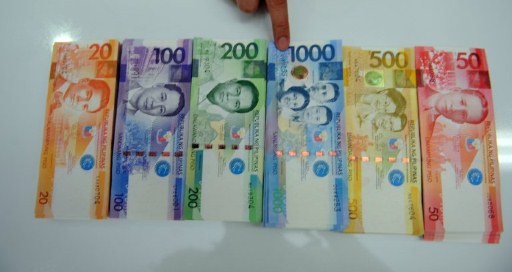Interest rate cut, lower inflation seen boosting growth

AFP PHOTO
MANILA, Philippines – The cut in interest rates augur well to economic growth moving forward alongside easing inflation, officials said.
“Easing monetary policy and making more funds available for investment, by businesses, by local as well as international businessmen, would help,” Socioeconomic Planning Secretary and National Economic and Development Authority chief Ernesto M. Pernia, the country’s chief economist, told a press conference Thursday, when asked about the benefits of an interest rate reduction to the economy.
Higher interest rates make it more expensive to borrow, such that some consumers defer purchases or consumption of certain goods while investors delay new or expansion plans.
The Bangko Sentral ng Pilipinas’ (BSP) policy-making Monetary Board later that day cut the policy rate by 25 basis points (bps) to 4.5 percent as it cited the declining headline inflation rate, making the outlook “manageable.”
Last year, the BSP hiked key interest rates by a total of 175 bps to arrest the faster-than-expected rate of increase in prices of basic commodities—a 10-year high of 5.2 percent—caused by new or higher excise taxes imposed by the government under the Tax Reform for Acceleration and Inclusion (TRAIN) Act, skyrocketing global oil prices, and domestic food supply bottlenecks, especially of rice.
Elevated inflation slowed annual gross domestic product (GDP) growth to a three-year low of 6.2 percent in 2018.
But inflation fell to a 16-month low of 3 percent in April, averaging 3.6 percent during the first four months—already within the government’s 3-4 percent target range.
In an economic bulletin on Friday, Department of Finance (DOF) Undersecretary and chief economist Gil S. Beltran said “slower inflation will continue to boost consumer expectations and, along with election campaign expenditures, will support a return to higher growth in household consumption.”
In a May 9 report, London-based Capital Economics said: “Further interest rate cuts seem only a matter of time.”
“Given the subdued outlook for inflation and the dovish nature of comments from the BSP, policy easing this year is likely to be more aggressive than we previously thought. We are now expecting two additional cuts before the end of the year,” Capital Economics Asia Economist Alex Holmes said.
“For one thing, inflation is likely to fall back further. The [BSP] mentioned the upside risk from higher oil prices. We think oil prices will fall back to around $60 per barrel by yearend. But even if prices remain at their current elevated level of $70 per barrel for the remainder of the year, oil price inflation would still continue to fall back for the rest of 2019,” Capital Economics explained.
“Food price inflation is also likely to continue to fall. The BSP raised concerns about the effect of El Niño on crop harvests. However, despite the disruption caused by the El Niño, the measures that the government has introduced to boost imports of rice should ensure that food price inflation continues to ease,” it added.
As such, Capital Economics expects inflation to average by about 1.5 percent year-on-year in the second half.
Also, Capital Economics said the underwhelming first-quarter GDP growth rate of 5.6 percent—the slowest in four years—would pave the way for more interest rate cuts.
“While some of this was due to temporary factors, we still think growth this year will be weaker than last year’s 6.2 percent. The lagged impact of last year’s rate hikes will continue to weigh on activity, and exports are set to struggle on the back of slowing global growth. The BSP noted in its statement that the outlook had worsened, in part because ‘global economic growth momentum has slowed,’” it said. (Editor: Abe Cerojano)